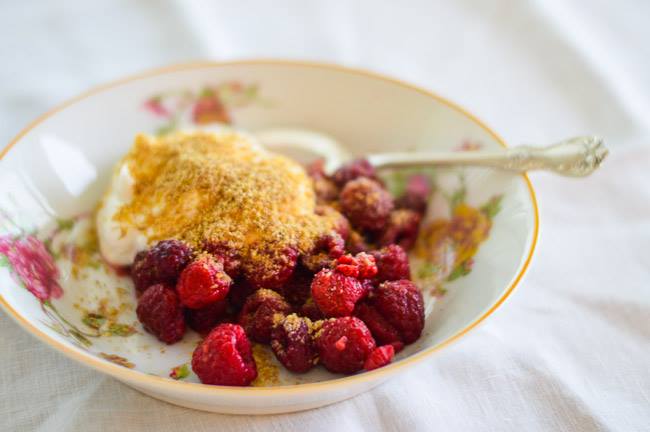
Fiber is found in the beautiful and tasty world of plant foods. Vegetables, legumes, nuts, seeds, whole grains and fruit all provide your body with fiber. This means everything ranging from the humble potato and canned kidney beans to popular quinoa and perfectly sweet raspberries contribute to daily fiber intake.
In fact, raspberries are a rich source of fiber. A one-cup serving contains up to 6 grams of fiber, or 21% of the USDA daily recommended value. This is significant since most Americans don’t eat enough fiber. Adults need about 25 – 38 grams of fiber a day, depending on age and gender. Yet, the average consumption is only 16 grams/day.
People can’t digest fiber since the body doesn’t have the enzymes to break it down—so it moves through the body intact. Depending on the type of fiber, it either acts as a gel, absorbing “bad cholesterol” and carrying it out of our body (soluble), or acting as a big scrub brush inside the intestines (insoluble). But, aside from keeping people regular – studies also indicate that dietary fiber can have the ability to boost immune health and may also help reduce the risk of obesity, type 2 diabetes, cardiovascular disease and certain cancers.
The American Heart Association (AHA), American Diabetes Association (ADA) and the American Cancer Society (ACS) all recommend a high-fiber diet for health and wellness and to prevent and/or manage chronic disease. Eating frozen raspberries is an easy, tasty way to increase daily fiber consumption.
Getting enough fiber by no means equates to chomping on bran muffins from dawn till dusk.
Here are 5 delicious ways to get your fiber fix.
- Bulk up your breakfast bowl. Stir frozen raspberries in your hot bowl of oatmeal and top with chopped walnuts or flaxseeds for a hearty dose of fiber. The cold raspberries will cool down your hot bowl of oats; it’s the perfect partnership.
- Sweeten naturally. Reduce the amount of refined white sugar in your recipes by half and use frozen raspberries to naturally sweeten your muffins and breads. It’s a win-win!
- Blend it up. Rather than juicing your fruits and veggies to remove the fiber, blend the whole fruit or veggie. Blend bananas, raspberries and spinach with a little orange juice for a nutrient-packed, fiber-rich beverage.
- Spread it on. Whole grain crackers and whole grain breads are the perfect vehicle for fiber-rich foods. Try making Raspberry Chia Fruit Spread as a substitute for jelly or jam. It’s an easy way to add fiber to your diet.
- Pump up your salads. Some salads may score low in the fiber department. Although not widely known, some lettuce provides less than one gram of fiber per cup. A few ways to get the most from daily greens is to top them with raspberries, seeds, nuts, veggies,
